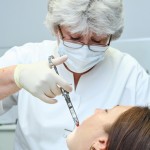
Effective local anaesthesia is important in order to undertake root canal treatment. If inadequate this can result in pain, increase fear and anxiety and prolong treatment time. Anaesthesia for mandibular teeth with irreversible pulpitis is usually achieved using inferior alveolar nerve block which has a failure rate estimated to vary between 43-83%. Supplemental techniques such as buccal infiltration, periodontal ligament injection, intra osseous injection and oral premedication have been shown to improve anaesthesia success. However, identifying the most effective anaesthetic solution would be helpful.
The aim of this review was to identify the most effective anaesthetic solution for inferior alveolar nerve blocks (IANB) for mandibular teeth with irreversible pulpitis.
Methods
Searches were conducted in the PubMed and Scopus databases. Randomised controlled trials (RCTs) in adult patients undergoing root canal treatment in mandibular teeth with irreversible pulpitis comparing at least two anaesthetic solutions for IANB were considered. Studies involving supplemental injections were excluded.
Two reviewers independently screened and selected studies extracted data and assessed the risk of bias of the included studies using the Cochrane tool. Pairwise meta-analysis, network meta-analysis using a random-effects model, and SUCRA (surface area under the cumulative ranking) were performed. The quality of evidence was assessed using the (GRADE) Grading of Recommendations, Assessment, Development and Evaluations approach.
Results
- 12 RCTs involving a total of 750 patients were included.
- 3 studies were considered to be at high risk of bias, the other 8 to be at low risk of bias.
- Pairwise Meta-analysis
- Articaine RR = 1.16 (95%CI; 1.02 – 1.32) and mepivacaine RR = 1.46 (95%CI; 1.04 – 2.07) had significantly higher success rates in IANB anaesthesia of teeth with irreversible pulpitis compared to lidocaine.
- Network Meta-analysis
- Only mepivacaine significantly increased the success rate of IANB compared to lidocaine RR=1.42 (95%CI; 1.04 – 1.95).
- No significant differences in the success rate of IANB were observed between mepivacaine and other anaesthetic agents (articaine and bupivacaine).
- Of all anaesthetic agents, mepivacaine (SUCRA = 0.81) ranked first in increasing the success rate of IANB, followed by prilocaine (SUCRA = 0.62), articaine (SUCRA = 0.54), bupivacaine (SUCRA = 0.41) and lidocaine (SUCRA = 0.13).
- The overall quality of evidence was very low to moderate.
Conclusions
The authors concluded: –
The results of network meta-analysis including all trials revealed that mepivacaine with epinephrine performed better than lidocaine with epinephrine in achieving higher IANB success rate in teeth with irreversible pulpitis and also ranked higher amongst other anaesthetic solutions. However, the network meta-analysis including only low risk of bias studies revealed no difference amongst the four anaesthetic solutions. Future high-quality randomized clinical trials are needed to confirm the results of our review.
Comments
The authors have followed a well-established methodology for this network meta-analysis. However, they have only included two databases and the use of additional databases may well have identified additional relevant studies. For example, the Cochrane Oral Health Groups Trials Register has one of the most complete record of RCTs in dentistry. In is interesting to note that the simple pairwise meta-analysis finds better performance from articaine and mepivacaine while the SUCA analysis ranks mepivacaine as the most effective. It should be noted, as highlighted by the authors, that when only the low risk studies are included the differences between the different agents disappears.
The authors also highlight that there were not able to take into account the influence of the quantity of anaesthetic agent or vasoconstrictors because of the limited number of studies. They also highlight the risk that another potential confounder, preoperative pain status is likely to have an impact. Consequently, while this review provides a helpful summary of the available data more high quality RCTs that provide good quality data all aspects of local anaesthesia including better information on potential confounders are required.
Links
Primary Paper
Nagendrababu V, Pulikkotil SJ, Suresh A, Veettil SK, Bhatia S, Setzer FC. Efficacy of local anaesthetic solutions on the success of inferior alveolar nerve block in patients with irreversible pulpitis: a systematic review and network meta-analysis of randomized clinical trials. Int Endod J. 2019 Jan 14. doi: 10.1111/iej.13072. [Epub ahead of print] Review. PubMed PMID: 30638269.
Other references
Dental Elf – 20th Jun 2018
Inferior alveolar nerve block: can NSAIDs improve anaesthetic success?
Dental Elf – 13th Apr 2018
Inferior Alveolar Nerve Block: improving anaesthetic success in patients with irreversible pulpitis
